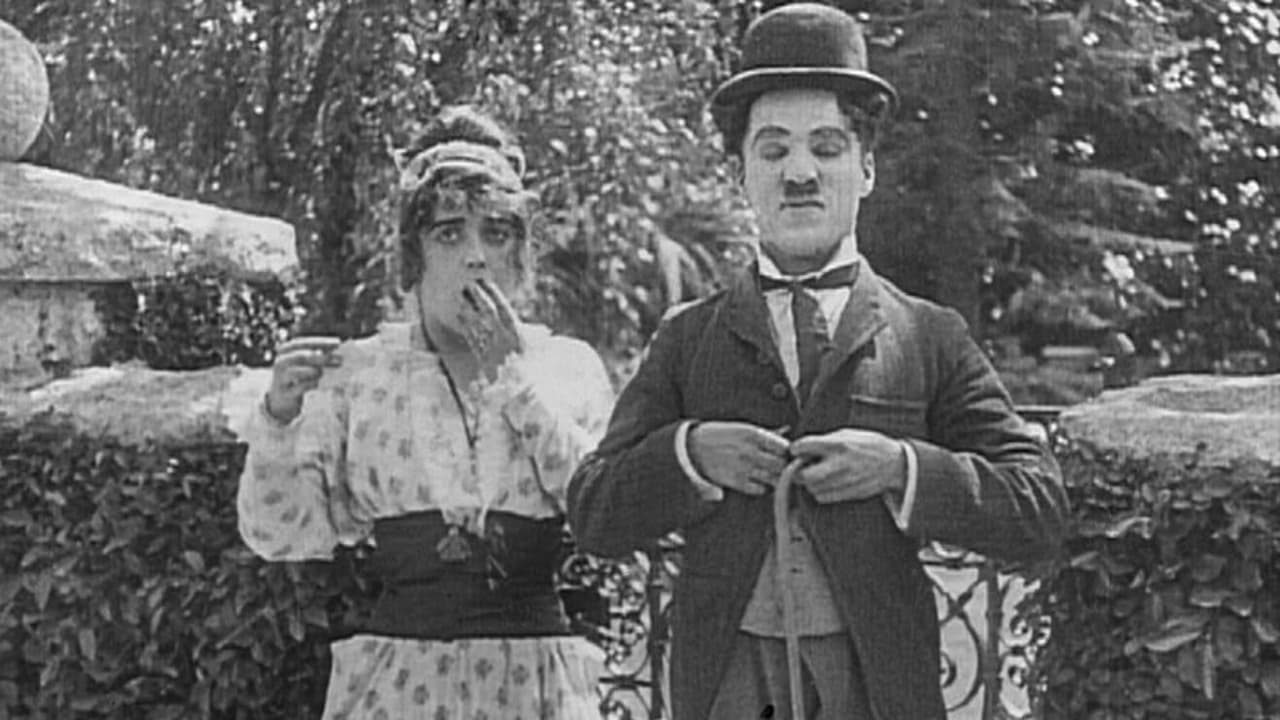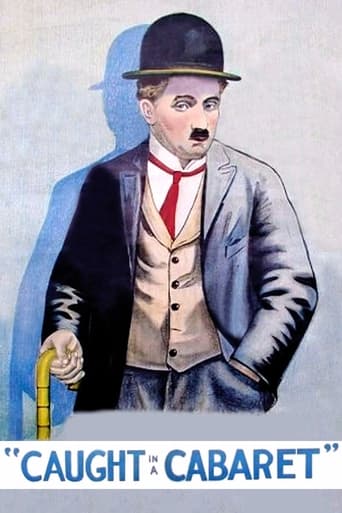

Am a big fan of Charlie Chaplin, have been for over a decade now. Many films and shorts of his are very good to masterpiece, and like many others consider him a comedy genius and one of film's most important and influential directors. He did do better than 'Caught in a Cabaret', still made very early on in his career where he was still finding his feet and not fully formed what he became famous for. Can understand why the Keystone period suffered from not being as best remembered or highly remembered than his later efforts, but they are mainly decent and important in their own right. 'Caught in a Cabaret' is a long way from a career high, but has a lot of nice things about it and is to me one of the better efforts in the 1914 Keystone batch and one of his better collaborations with Mabel Normand. 'Caught in a Cabaret' is not as hilarious, charming or touching as his later work and some other shorts in the same period. The story is flimsy and the production values not as audacious. Occasionally, things feel a little scrappy and confused.For someone who was still relatively new to the film industry and had literally just moved on from their stage background, 'Caught in a Cabaret' is not bad at all. While not audacious, the film hardly looks ugly, is more than competently directed and is appealingly played. Chaplin looks comfortable for so early on and shows his stage expertise while opening it up that it doesn't become stagy or repetitive shtick. Although the humour, charm and emotion was done even better and became more refined later, 'Caught in a Cabaret' is humorous, sweet and easy to like, though the emotion is not quite there. It moves quickly and doesn't feel too long or short. Overall, far from one of Chaplin's best but pretty good and perhaps one of his better efforts from the early Keystone period. 7/10 Bethany Cox
... View MoreWatching Charlie Chaplin's Keystone comedies is like watching the earliest appearances of classic cartoon characters such as Mickey Mouse or Bugs Bunny; that is, our hero is certainly familiar yet not quite himself, and is crude in both appearance and behavior, sometimes to a startling degree. It's fascinating to see these early works, but they can be a little disquieting, too. In some Keystones Chaplin is an outright villain, shockingly mean-spirited and dastardly. In others, however, he is comparatively benign, as in Caught in a Cabaret, an early short I enjoy, which is of special interest for several reasons.When this film was made Chaplin was not yet his own director. Caught in a Cabaret was directed by his co-star, Mabel Normand, who had clashed with the temperamental Englishman on their previous collaboration, Mabel at the Wheel. Studio boss Mack Sennett almost fired Chaplin on that occasion, but by the time this follow up was made, it appears that all was forgiven. (Chaplin's burgeoning popularity with the public was surely a big factor in saving his career at Keystone.) Both stars contributed to this film's scenario, and here is where we find a number of elements Chaplin would develop and refine later on. The basic premise is certainly familiar: Charlie is a lowly waiter who pretends to be a dignitary, and finagles an invitation to a party where he mingles with the upper crust, which makes this short a blue-print for a number of memorable comedies yet to come, including The Count, The Rink, and The Idle Class, among others. Naturally, the prototype isn't as polished as the later works, but hey, you have to start somewhere. As a bonus, Caught in a Cabaret offers a rogue's gallery of Keystone players in support: Edgar Kennedy, Chester Conklin, Minta Durfee, Mack Swain, etc., all emoting at full throttle, not to mention the lovely Mabel as leading lady, so there's plenty to enjoy as this two-reel extravaganza unfolds.The cabaret where Charlie works is a real dive, seamy and scuzzy. During the cabaret scenes director Normand crowds the frame with so much rowdy activity—people carousing, raising hell, caterwauling, whatever—that the joint looks like Bedlam. When Charlie steps outside to walk his dog, we're treated to grimy location shots taken in L.A.'s old Chinatown district, a ghetto that would be demolished in the '30s. By way of contrast, Mabel plays a "Society Bud" of noble lineage who lives in a mansion, and it's clear that she and her foppish boyfriend (Harry McCoy) travel in more rarefied circles. The denizens of these very different worlds meet up in a park, where Charlie defends Mabel from a thief while her boyfriend cowers. But it's not enough for Charlie to be a hero; he must claim to be an important figure to impress this young lady, though once he's invited to her party he forgets himself and promptly gets hammered. Harry the fop gets his revenge by inviting his society pals to go slumming at the very cabaret where Mabel's new love interest works, thus revealing his true status. It all ends in a classic Keystone mêlée, although oddly it's cabaret boss Edgar Kennedy who inexplicably freaks out and shoots up the place.There are a number of moments to savor: Mabel and Charlie sharing an intimate moment during the party, and singing along with the musicians; Minta Durfee's saucy dance in the cabaret; tough guy Mack Swain picking his teeth with a pistol; and finally, Mabel's horrified reaction at the end, when she learns that Charlie isn't really a V.I.P. (You can read her lips: "A WAITER? Oh my God!") The only thing that troubles me about this amusing short is the fate of Charlie's lively little dog. He makes quite an impression during his brief sequence before the cameras, but when Charlie returns to the cabaret from the park, the dog is no longer with him. Where did he go? And didn't anyone notice?
... View MoreCaught in a Cabaret (1914) *** (out of 4) Chaplin is mistaken as a Greek Ambassador and must keep a girl's family from finding out. This one here is a real riot with some wonderfully funny fight scenes but the real highlights are the title cards, which feature some very funny one-liners. Also of note is that this storyline would play a big part in future Chaplin films.A Busy Day (1914) ** (out of 4) Chaplin plays a woman(!) who gets tired of her husbands and decides to fight with him in public. This here really doesn't have a single funny moment but it's still interesting to see Chaplin playing a woman.Fatal Mallet, The (1914) *** (out of 4) Chaplin, along with two other guys, fights for the affection of a woman. Instead of using their fist the guys instead throw bricks at one another. This is a very funny film that has some outrageous violence that makes for a good time.Knockout, The (1914) *** (out of 4) To show off his braveness, Fatty Arbuckle challenged a professional boxer to a fight. Fatty is funny as usually and like the above film, this one here gets the laughs from violence ranging from punches to items being thrown. Chaplin has a small but funny cameo as the referee.
... View MoreUnfortunately, Caught In A Cabaret, being one of Chaplin's earliest films, has deteriorated pretty badly over the last nine decades or so, and this deterioration seems to have affected the film's continuity, making it look like the editing is botched. As is the case with most of Chaplin's films, the action in Caught In A Cabaret runs slightly faster than real life, which enhances much of the slapstick comedy but also makes several short clips in the film go by so fast that they are virtually incomprehensible. (spoilers) The main theme of Caught In A Cabaret deals with rich vs. poor, a theme that Chaplin later became famous for and which he made use of so often because of his own poverty stricken childhood. This film concerns a working man who pretends to be someone else in order to get accepted into a group of wealthy people. It is not expected that at the end he does not get the girl and winds up walking down a dirt road alone, but his activities throughout the film make his point clear. As he is at a party with the rich people, he gets drunk and makes something of a fool of himself, but when he is working as a waiter, he is fairly heroic, ridding the place of unwanted ruffians and whatnot. Caught In A Cabaret has not survived too well physically, but it is an excellent example of the type of early work Chaplin did as he became famous as one of the most loveable characters in cinematic history.
... View More